“Don’t Get Paint on the Ceiling”
Creating a Fly Angler from the Water Up
From Tail Fly Fishing Magazine #20 November 2015
By Joshua Wrigley
Photos: Doug Baz
When trying to describe the execution of a fly cast, I am frequently tempted to use the terms, grace, power and timing. Of course, these words are abstract enough so that they can mean anything, especially to someone who has never held a fly rod before. Even though those qualities may seem self-evident to an experienced fly angler, they are difficult to translate into something that a novice can visualize. I don’t remember exactly what I was told to do when I learned how to cast. Mostly it was a process of repetition in the back yard between a barn and a stand of apple trees, trying not to get the line caught and picking out wind knots.
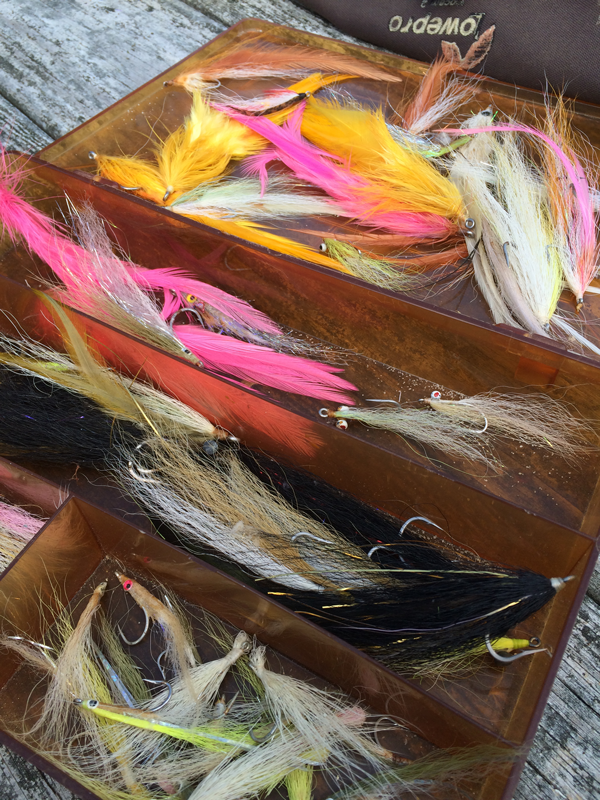 Even though I fish on a regular basis, I have never tried to teach the practice of fly fishing (casting and all other aspects). In some ways, the thought is daunting since it challenges the teacher to impart formal skills that have long become reflexive motions. Like most skills, this one climbs a slow learning curve until it becomes permanently ingrained.
Even though I fish on a regular basis, I have never tried to teach the practice of fly fishing (casting and all other aspects). In some ways, the thought is daunting since it challenges the teacher to impart formal skills that have long become reflexive motions. Like most skills, this one climbs a slow learning curve until it becomes permanently ingrained.
At a recent saltwater fly fishing class that I organized, Patrick Grenier, an FFF casting instructor and member of Cape Cod Trout Unlimited, set up a row of cardboard panels in the presentation room at Mass Audubon’s Long Pasture Wildlife Sanctuary. Side by side, they depicted a false cast with the line extending back in a loop and then straightening out. For the audience of mostly first-time fly-rodders, the visual illustration struck a chord. As he switched the panels to illustrate the loop opening, he explained that the rod’s smooth acceleration and abrupt stop controlled the line’s momentum and the loop itself.
Out on the lawn, the program participants picked up a mix of 8 and 9 weight outfits and tried casting to hoops laid in the grass in front of them. Loops of various widths cut through the air as they began to feel how the rods loaded with different lengths of line. As people fiddled with their rods and made a few half-hearted attempts to get their lines in motion, the other two instructors – Ted Patlen and Scott Dietrich – shared advice on the proper arm motions and keeping the line in the air. Verbal imagery helped them comprehend the mechanics of the cast.
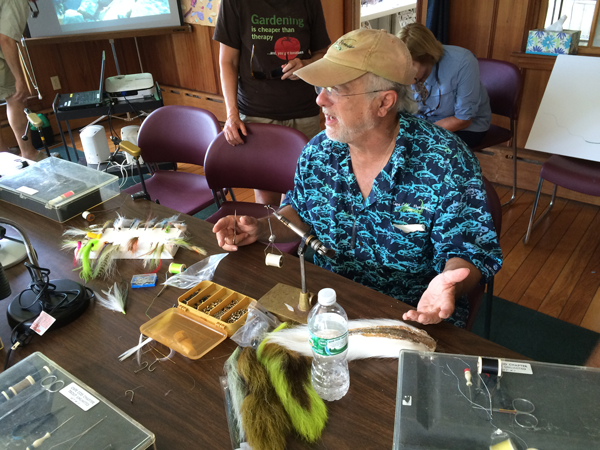 In some ways, the motion is analogous to throwing paint at walls both in front and in back. The straight back and forth motion of a simulated paint brush comes close to the movement of one’s casting arm as it accelerates and abruptly stops. Imagining that back and forth trajectory helped them to visualize the motion especially as it came with the direction to not get paint on the ceiling. Draw the line off the water smoothly but with enough force so that it straightens out in back. Wait for it to unfurl and in the split second before its energy dissipates, bring the rod forward to transfer its energy into a mirror image loop.
In some ways, the motion is analogous to throwing paint at walls both in front and in back. The straight back and forth motion of a simulated paint brush comes close to the movement of one’s casting arm as it accelerates and abruptly stops. Imagining that back and forth trajectory helped them to visualize the motion especially as it came with the direction to not get paint on the ceiling. Draw the line off the water smoothly but with enough force so that it straightens out in back. Wait for it to unfurl and in the split second before its energy dissipates, bring the rod forward to transfer its energy into a mirror image loop.
For the sanctuary, this was a foray into a different style of educational program. Located on 101 acres of property adjacent to Barnstable Harbor, the Visitors Center overlooks the embayment’s blue waters and Sandy Neck Barrier Beach. During the school year, student groups explore the mudflats for lug worm egg cases and calico crabs. In December, visitors venture to the shore in search of winter ducks such as Eiders and Scoters floating buoyantly atop the harbor’s frigid waters. Fly fishing might seem like a strange intruder into the mix, and yet an ethos of conservation and stewardship brings fly fishing into harmony with other avocations that strive for a similar communion with nature.
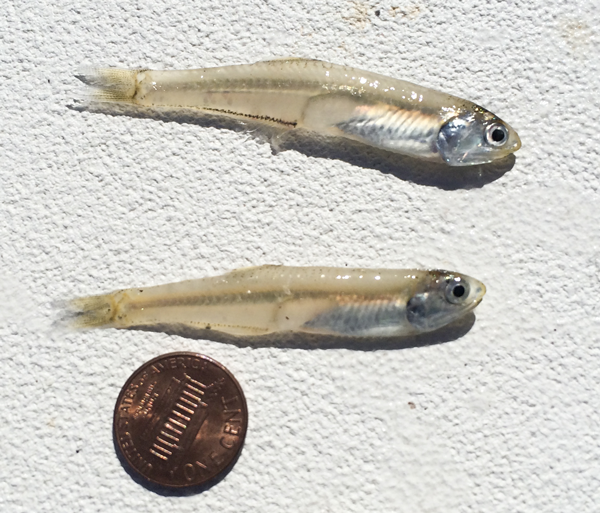 Saltwater fly fishing is in essence an exploration of the coastal environment, and requires the same skills as that of a naturalist or birder. Observing how species interact ultimately allows the angler to understand how living components of the environment fit together. On a June morning, multiple tern species gliding over a beach may reveal the identities of forage fish that have become trapped on an exposed bar by the dropping tide. Likewise, during a moonless September night, the muffled handclap sound of striped bass feeding on the surface draws an angler’s attention. In the rushing waters of the flooding tide the predators push young alewives up against a gravel bar, their silvery forms sounding like rain pelting the water’s surface. Such incidences are common to those who patrol the shore in search of gamefish. The phenological events that one encounters are just as much markers of time as the dates on a calendar.
Saltwater fly fishing is in essence an exploration of the coastal environment, and requires the same skills as that of a naturalist or birder. Observing how species interact ultimately allows the angler to understand how living components of the environment fit together. On a June morning, multiple tern species gliding over a beach may reveal the identities of forage fish that have become trapped on an exposed bar by the dropping tide. Likewise, during a moonless September night, the muffled handclap sound of striped bass feeding on the surface draws an angler’s attention. In the rushing waters of the flooding tide the predators push young alewives up against a gravel bar, their silvery forms sounding like rain pelting the water’s surface. Such incidences are common to those who patrol the shore in search of gamefish. The phenological events that one encounters are just as much markers of time as the dates on a calendar.
Understanding the behavior of marine organisms and predator/prey relationships allows one to mimic natural forms when fishing and when constructing flies. Award winning fly tier Ted Patlen emphasized this point during his fly tying demonstration. Sitting in the sanctuary presentation room, he wove strands of bucktail around a hook all the while talking about the virtues of sparse versus bulky imitations. “You give the illusion of size,” he said, motioning to a Deceiver in the vice. In the back of the room a projector indicated different forage species that frequent New England’s waters. Alewives, blueback herring, menhaden, longfin squid, silversides and bay anchovies were among those that played across the screen. Tying a fly is not about exactly recreating a baitfish. It is about capturing the essence or even the suggestion of a baitfish so that its motion in the water will trigger a fish’s predatory instincts.
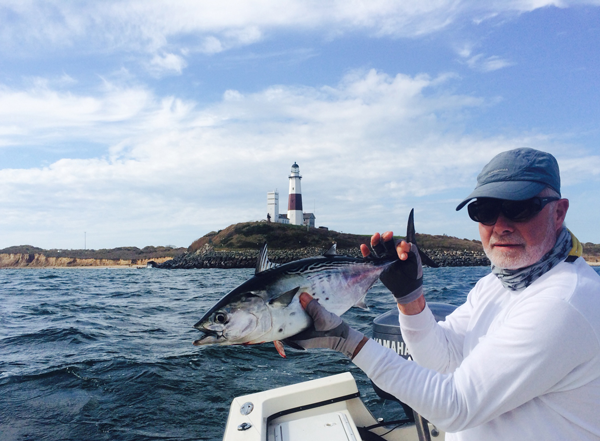
The anglers in the class had an opportunity to put their skills into practice several weeks later on Sandy Neck, a barrier beach that separates Cape Cod Bay from Barnstable Harbor to the south. Over five miles long, it offers a series of sandbars and channels along its north side while the southern edge of the beach consists of an intricate latticework of marsh creeks. With the aid of a vehicle, we roved over the dunes keeping an eye out for fish and birds. As the tide flooded, the sandbars that lay exposed gradually filled in and the channels deepened, bringing schools of forage fish across the shallows. From the upper beach near the cordgrass, we could watch pods of juvenile menhaden move erratically as they came over the bars and disappeared into deeper areas.
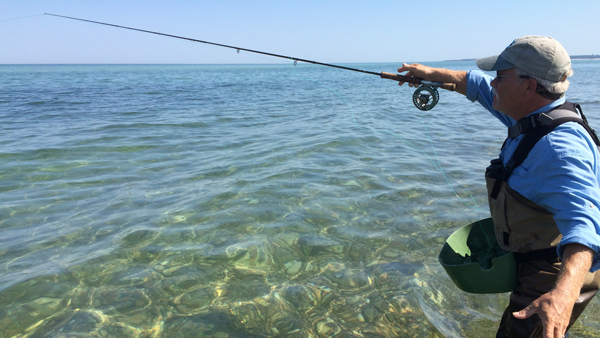 As the tide continued filling in the pockets, blue merged with gold obscuring individual bars. This “in-the-field” extension of the program, enabled participants to see the configuration of a beach change under different tidal conditions. The one fish of the day even helped demonstrate a lesson that had been made by guide Scott Dietrich: that fish will frequently traverse routes close to the beach when actively hunting. This striper had cruised into a bowl-like depression behind a sandbar and was accessing a channel parallel to the shore.
As the tide continued filling in the pockets, blue merged with gold obscuring individual bars. This “in-the-field” extension of the program, enabled participants to see the configuration of a beach change under different tidal conditions. The one fish of the day even helped demonstrate a lesson that had been made by guide Scott Dietrich: that fish will frequently traverse routes close to the beach when actively hunting. This striper had cruised into a bowl-like depression behind a sandbar and was accessing a channel parallel to the shore.
Every outing to the water’s edge is different owing to the variables of weather and tide. However, understanding how both predators and prey use a beach for refuge, hunting and travel remains a critical base of knowledge when venturing into the surf. Combined with the mechanics of casting, the amount one needs to know may seem staggering. And yet, familiarity with these elements of the shore may not only make one a better angler but may also foster a deeper appreciation for the natural world.
fly fishing magazine
tail fly fishing magazine

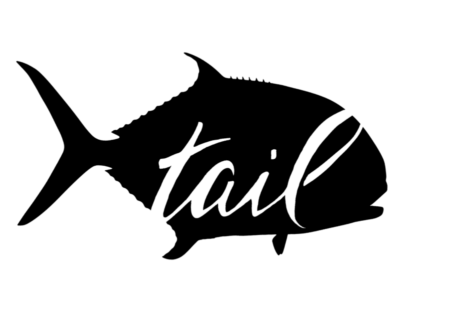 SUBSCRIBE TO READ MORE
SUBSCRIBE TO READ MORE